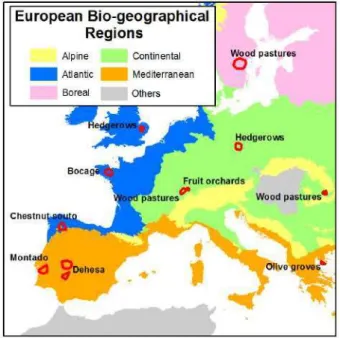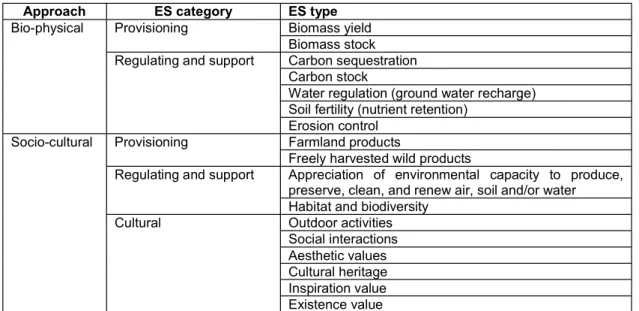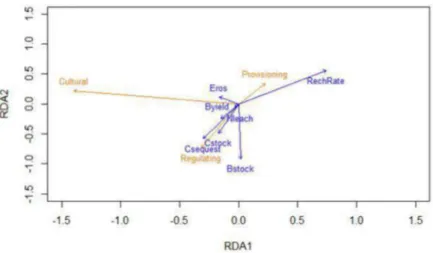EXPLORING THE RELATIONSHIPS AMONG
BIO-PHYSICAL AND SOCIO-CULTURAL ECOSYSTEM
SERVICES OF AGROFORESTRY SYSTEMS ACROSS
EUROPE
Roces-Diaz JV1*, Rolo V2, Kay S1, Moreno G2, Szerencsits E2, Fagerholm N3, 4, Plieninger T3, Torralba M3, Graves A5,
Giannitsopoulos M5, Palma J6, Herzog1
(1) Agroscope, Department of Agroecology and Environment, Zurich, Switzerland (2) Forestry Research Group, Universidad de Extremadura, Plasencia, Spain (3) Department of Geosciences and Natural Resource Management,
University of Copenhagen, Copenhagen, Denmark (4) Department of Geography and Geology, University of Turku, Turku, Finland (5) Cranfield University, Bedfordshire, United Kingdom (6) Forest Research Centre, School of
Agriculture, University of Lisbon, Lisbon, Portugal *Corresponding author: jvroces@gmail.com
Abstract
Agroforestry systems are often highlighted for their multifunctional role, the different goods and services provided, but also for their social-relevance in different European rural landscapes. However the connections among the bio-physical ecosystem services (ES) and the socio-cultural values of these landscapes are still underexplored. With the aim of to assess if perceived ES are related to measured and modelled biophysical ES and land use types, we combined seven spatially explicit models of ES and a dataset with more than 2,300 records of public participatory GIS for 12 European landscapes. We found that biophysical ES had variable relevance in predicting socio-cultural ES. In addition, when we analyzed relationships among ES, we found that, in general, biophysical ES values were negatively related to the occurrence of socio-cultural ES. Thus, further research should be developed to explore these potential connections among ES.
Keywords: agroforestry systems; European rural landscapes; PPGIS; ecosystem services modelling
Introduction
The multifunctional role of traditional European agricultural landscapes, but also their general decline during the last decades, has been highlighted by e.g. Jongman (2002) and Antrop (2005). These landscapes involve different types of ecosystems, including forest patches and (semi-)natural vegetation (only a small part of European landscapes involves natural vegetation sensu stricto). Most of these landscapes also have notorious presence of agroforestry patches -as p-astures, arable lands, etc. with variable density of wood elements (den Herder et al. 2017). Different typologies of European landscapes show different types of agroforestry systems (AFS) (Eichhorn et al. 2006) adapted to different climatic and socio-ecological conditions. Most of them have been part of these landscapes since hundreds of years.
From the beginning, these AFS have provided a wide range of ecosystem services (ES), including for example firewood or food as provisioning services and erosion control or soil fertility regulation (Torralba et al. 2016; Pardon et al. 2017) as regulating ES. These services were usually studied by using bio-physical measurements and modelling (Kay et al. 2017). More recently, the socio-cultural ES provided by AFS have also attracted attention (Fagerholm
At the landscape scale, the spatial location of the areas relevant for specific ES with Public
Participatory Geographic Information Systems (PPGIS) has grown in relevance during last years (Brown and Fagerholm 2015).
Until now, only few authors have studied the interactions between the different categories of ES (Garcia-Llorente et al. 2015), and only at a sub-regional/local scale. We therefore investigated the relationships between provisioning, regulating and socio-cultural ES by combining biophysical measurements and modelling with PPGIS interviews in twelve case study areas across European agroforestry landscapes (Figure 1). Here, we explore a methodology that can lead to an integrated analysis along a broad geographical gradient and combining different scientific disciplines (bio-physical and socio-cultural research methods).
Materials and methods Study area
We studied twelve study cases which represent different European rural landscapes from four biogeographical regions including Mediterranean (4 cases), Continental (4), Atlantic (3) and Boreal (1) shown in Figure 1.
Figure 1: Location of the agroforestry system study cases.
Cartographic data sources
We produced a specific map of habitat types derived from existing information, namely land use maps (Corine Land Cover CLC-; EEA 2012), forest cover (Tree Cover Density TCD; EEA 2016) and a semi-automatic aerial photograph interpretation. Combining these sources of spatial information, we classified our study areas into the following broad land cover classes:
Bio-physical ES models
We used a series of spatially explicit models that reflect different provisioning and regulating ES for our study areas. To this end, in the case study regions the agroforestry areas, the agricultural areas and the forestry areas (if applicable) of the study regions, four 1 km squares per study region and land cover type were randomly sampled and mapped (habitats). Biophysical ES were then evaluated with appropriate models (Kay et al. 2017). In order to expand these ES models from the 1 km squares to the study area limits, values representing average results for each of the five classes of land use were used. Table 1 shows the different bio-physical ES assessed.
Table 1: Different types of biophysical and socio-cultural ecosystem services (ES) assessed.
Approach ES category ES type
Bio-physical Provisioning Biomass yield
Biomass stock
Regulating and support Carbon sequestration
Carbon stock
Water regulation (ground water recharge) Soil fertility (nutrient retention)
Erosion control
Socio-cultural Provisioning Farmland products
Freely harvested wild products
Regulating and support Appreciation of environmental capacity to produce,
preserve, clean, and renew air, soil and/or water Habitat and biodiversity
Cultural Outdoor activities
Social interactions Aesthetic values Cultural heritage Inspiration value Existence value Socio-cultural ES assessment
In each study case, PPGIS were conducted and the results assembled in a database, which provides a series of points (between 1,000-2,500 per study region). These points were identified by local inhabitants as relevant in relation with different socio-cultural ES. The socio-cultural ES were aggregated to 10 types as shown in Table 1.
Spatial analysis and general results
To each study case, we applied a 100x100 meter grid. For each cell average values of bio-physical socio-cultural ES were calculated. Using the combined bio-bio-physical and socio-cultural ES database we analysed the relationships among different types of ES, as well as the effect of AFS on these relationships. To analyse how biophysical ES can help to predict socio-cultural ES, we run a Redundancy Analysis (RDA) using socio-cultural ES as response variables and biophysical ES as predictors (Figure 2).
Figure 2: Redundancy analysis (RDA) showing the relationship between the three general types of surveyed ES (yellow) and seven modelled biophysical ES predictors (blue).
Our results showed that surveyed provisioning and regulating ES were negatively related, having socio-cultural ES no relationship with any of them (Figure 2). Surveyed regulating ES were positively related to model regulating ES, particularly to Cstock and Csequest. By contrast, surveyed provisioning ES were positively related to recharge rate, confirming the positive association between modelled and surveyed ES.
We then ran individual GLM models with a bionomial distribution for each socio-cultural ES to assess how bio-physical ES affected the probability of occurrence of socio-cultural ES. We expected significant relationships among those ES from both types tested (bio-physical and socio-cultural), which were thematically similar. Thus for example, we expected that those areas with high values of supply of ES would be also identified by the PPGIS process as relevant for provisioning ES. However, we observed that, in general, biophysical ES values were negatively related to the occurrence of socio-cultural ES, indicating that PPGIS points were located in places with low values of biophysical ES (mainly in artificial land use types).In addition, we did not observed a positive role of AFS, although positive effects of AFS as ES providers in agricultural landscapes is accepted (Jose 2009; Torralba et al. 2016; Pardon et al. 2017).
Acknowledgments
We acknowledge funding through Grant 613520 from the European Commission (Project AGFORWARD, 7th Framework Program). JVRD was supported by the Government of Asturias and the FP7-Marie
Curie-ACA17- 02).
Fagerholm N, Torralba M, Burgess PJ, Plieninger T (2016) A systematic map of ecosystem services assessments around European agroforestry. Ecol Indicat 62: 47-65.
Garcia-Llorente M, Iniesta-Arandia I, Willaarts BA, Harrison PA, Berry P, Bayo MM, Castro -B (2015) -Biophysical and sociocultural factors underlying spatial trade-offs of ecosystem services in semiarid watersheds. Ecol Soc 20: 39.
Jongman RHG (2002) Homogenisation and fragmentation of the European landscape: ecological consequences and solutions. Landsc Urban Plan 58: 211 221.
Jose S (2009) Agroforestry for ecosystem services and environmental benefits: An overview. Agrofor Syst 76: 1-10. Kay S, Crous-Duran J, Ferreiro- G, Mosquera-Losada MR, Palma
JHN, Roces- -Freijanes JJ, Szerencsits E, Weiberl R, Herzog F (2017) Spatial similarities between European agroforestry systems and ecosystem services at the landscape scale. Agroforst Syst doi.org/10.1007/s10457-017-0132-3
Pardon P, Reubens B, Reheul D, Mertens J, De Frenne P, Coussement T, Janssens P (2017) Trees increase soil organic carbon and nutrient availability in temperate agroforestry system. Agriculture Ecosyst Environ 247: 98-111.
Torralba M, Fagerholm N, Burgess PJ, Moreno G, Plieninger T (2016) Do European agroforestry systems enhance biodiversity and ecosystem services? A meta-analysis. Agriculture Ecosyst Environ 230: 150 161.


